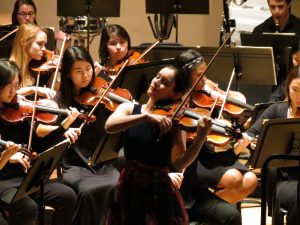
Saturday, Nov. 19, marked the beginning of the unofficial end-of-semester concert series at Slosberg, with the always well-anticipated performance of the Brandeis-Wellesley Orchestra. Composed, as the name suggests, by students from both Brandeis University and Wellesley College, the group has had a large impression on the campus music scene since its inception nearly 14 years ago, under the continuous direction of conductor Neal Hampton (MUS). The night featured works by composers which were lesser known to general audiences, yet were in no way mediocre nor esoteric for those who regularly enjoy or are familiar with classical music.
The performance opened with George Bizet’s “Farandole from L’Arlesienne Suite No. 2.” Originally from the play “L’Arlésienne,” which was performed rather unsuccessfully in comparison to its prominence after being reworked as an orchestral suite, this piece was actually taken from the fourth movement of a second suite arranged by Bizet’s friend, Ernest Guirard. Just over three minutes long, this piece was the perfect show opener, displaying the orchestra’s wide range in both tone and volume. Author of the performance’s program notes, Katherine Horgan writes, “The two themes, the march-like opening theme, and the second light, dancing theme of the woodwinds combine to create a rollicking folk dance that increases in intensity until it arrives at a bombastic finish,” a concise and befitting description of the truly joyful nature of the piece.
Next was Felix Mendelssohn’s “Concerto for Violin and Orchestra in E minor op. 64,” featuring guest violinist Andrea Segar. The newest member of Brandeis’ well-known Lydian String Quartet, Segar has an extensive repertoire as a soloist across the country, working with many different groups from the Oklahoma City Philharmonic to the Grammy-nominated ensemble, A Far Cry. Segar demonstrated these years of experience with her masterful performance as the soloist of this piece. Chock-full of challenging dynamics and techniques, the piece was simply no match for Segar’s prowess.
Beyond its difficulty, the piece also features a healthy mixture of both traditional and new stylings from the era in which it was composed, even so far as to have the distinction of being the first named concerto to have all of its three movements connected. “Though a deeply learned composer, attracted to complex counterpoint and classical structure,” Horgan again writes, “Mendelssohn here takes his learning lightly, creating one of the most endearing classics of the concerto genre,” referencing Mendelssohn’s key to fame which comes through his inventive stylistics and lack of consideration for the stagnancy of traditional forms.
The closing piece of the night was César Franck’s “Symphony in D Minor,” a fitting choice as its three movements combined lasted approximately 45 minutes and was the sole focus of the show’s second half. This was Franck’s only symphony and one of the final compositions he ever wrote. The piece not only demonstrates the fusion of traditional French and German forms of music, but also serves as an outstanding example of the cyclic thematic style, with its most notable “faith” theme greatly prevalent in the piece’s first and third movements. Though described by music critic, Camille Bellaigue, as “arid and drab music, without … grace or charm,” which the song was more or less at times given its length, the piece had joyful moments just like the opening Bizet piece that made the rest of the composition exponentially more enjoyable.
Given what some would call a “meager” experience of the student performers in comparison to the majority of professional musicians, this performance surely showed no deviation from what one would expect from a standard $50 orchestra showing. Every performance by this group leaves few unamazed by the sheer amount of talent in these students and the amount of effort put into pulling off such a flawless performance.
However, what is more interesting is the timelessness of the music, being performed by young students over 100 years after its original composition. As noted in the orchestra’s program, “Uniting the high standards of excellence associated with Brandeis and Wellesley, the orchestra is dedicated to bringing inspiring performances of the great orchestral literature, both past and present, to a new generation of musicians and audiences.”


